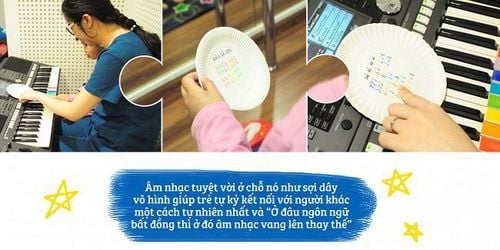This is an automatically translated article.
Article by Expert Nguyen Thi Yen - Speech therapist - Unit of Regenerative Medicine Clinic and Educational Psychology - Vinmec Times City International Hospital
Visual aids or visual strategies is a term for tools that present information using images, symbols, symbols, writing, and objects to provide visual cues helps users, who have difficulty understanding and using language, to communicate effectively with others.
1. The importance of visual support with autistic children With autistic children, many studies have shown that visual aids are useful tools to help children communicate more easily. Through the use of pictures and signs, children can perform different communication functions (for example, expressing needs, asking and answering information,...); while reducing challenging behaviors by "knowing" the schedule of activities. In addition to helping children communicate more easily, visual aids also help the person communicating with the child to understand and respond appropriately to the needs of the person with autism.
There are many visual aids suitable for people with autism, in which, the visual schedule is one of the most popular and useful tools. A visual schedule is a collection of images of activities, steps in a particular process of activity.
2. Visual aids for children with autism 2.1 Types of visual schedules Children understand and communicate at different levels. Some children only understand when they see real objects; children can recognize pictures of objects; Some children also understand through writing. Therefore, depending on the child's ability, the visual schedule will be divided into the following levels:
Use real objects Use photos of real things Use color drawings (cartoon images) Using line drawings Using writing Visual tools are more useful when children have pre-requisite skills such as:
The ability to pay attention to objects, images The ability to understand the meaning of objects and images Get motivated to communicate with others 2.2 How to build a visual schedule To build a useful activity schedule with your child, you need to:
Write down daily activities in detail, from the time your child wakes up until the day he or she wakes up. until the child goes to bed with a set time. Depending on the child's understanding, choose the appropriate visual tool (with real objects, real photos, drawings,...) Design a visual schedule

Hỗ trợ trẻ tự kỷ có vai trò quan trọng
2.3 Design a visual schedule Prepare necessary materials: cardboard (fomex), scissors, double-sided abrasive tape, pictures for the schedule (photographs, drawings, real objects,... optional) depending on the child's understanding)
Choose images for the schedule:
(+) You should start from "fixed" daily activities such as: mealtime, playtime,... You can also Choose to make a schedule for an activity or half a day, or a full day - if your child can follow it.
(+) Selected images need to be clear, minimize redundant things in the image (for example, only select images of toothbrushes and toothpaste, do not select images that include toothbrushes and cream as well. toothbrush and soap, etc.).
(+) The selected image should correspond to each activity that will be on the child's schedule.
(+) The images need to be of similar size, ensuring that they are suitable for the child's understanding.
- Print, laminate for long-term preservation and use of images, cut each image and stick sandpaper (thorns) fixed on the back of the image.
- Create a schedule board: You cut the cardboard (fomex) to fit the child's schedule, then stick the dare tape (the cotton part) running along the middle of the cardboard. You can design the schedule vertically or horizontally. Notice how the design adds a small pocket showing “work done” in the corner of the schedule board.
2.4 Teach your child to use a visual schedule Show your child a visual timetable. You can let your child touch to feel and start manipulating the images included in the schedule (tear, glue, save). When you're first teaching your child to use a schedule, you may need a lot of help to help your child understand the "process" of the operation, you can point to pictures and name the activity that needs to be done. After your child completes an activity, you can take the child's hand to tear the picture of the completed activity and put it in the “Done” bag. When switching activities, you may need to remind your child to “Let's go see the schedule.” This will help children focus more on the task they need to do. At first, you may need to spend more time with your child to provide support when needed. It can be physical support such as holding hands at first, then gradually reducing the support towards the goal that the child can use the schedule independently.

Dạy trẻ sử dụng lịch trình bằng hình ảnh
Note:
You should start with small and short activities for children to understand how to use. For example, activities include 2 steps Before – After, then gradually increase the number of activities and images accordingly. Use uniformly and fixed for a period of time. The schedule board should be in a position that is easy for children to see and get. Children need to see a schedule before they start doing a particular activity. For each picture, you should write a caption with a few words, for example: mealtime, playtime, etc. This will help children become familiar with the written word, and help unify among the people who support the child. The clinic and educational psychology unit of the Center for Regenerative Medicine Vinmec Times City Hospital is a pioneer in applying scientific and artistic methods to evaluate and treat children with autism, bringing high efficiency. .
Areas of educational intervention for children with autism at Vinmec: Clinical psychology - educational psychology; Special Education; Speech therapy; Meditation – therapeutic yoga; Music therapy; Art therapy
The team of doctors, therapists and teachers at the Center are trained at prestigious schools: University of Education, University of Social and Human Sciences - Hanoi National University, Academy of Sciences education management... and regularly learn to improve skills through short-term and long-term training courses at home and abroad with leading experts from the US, Australia, India, Italy.
Please dial HOTLINE for more information or register for an appointment HERE. Download MyVinmec app to make appointments faster and to manage your bookings easily.













